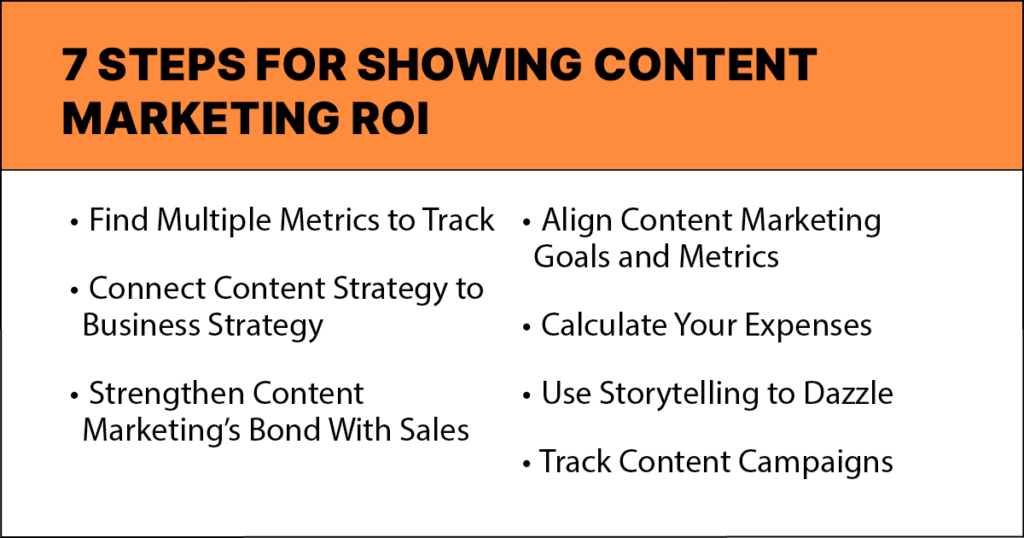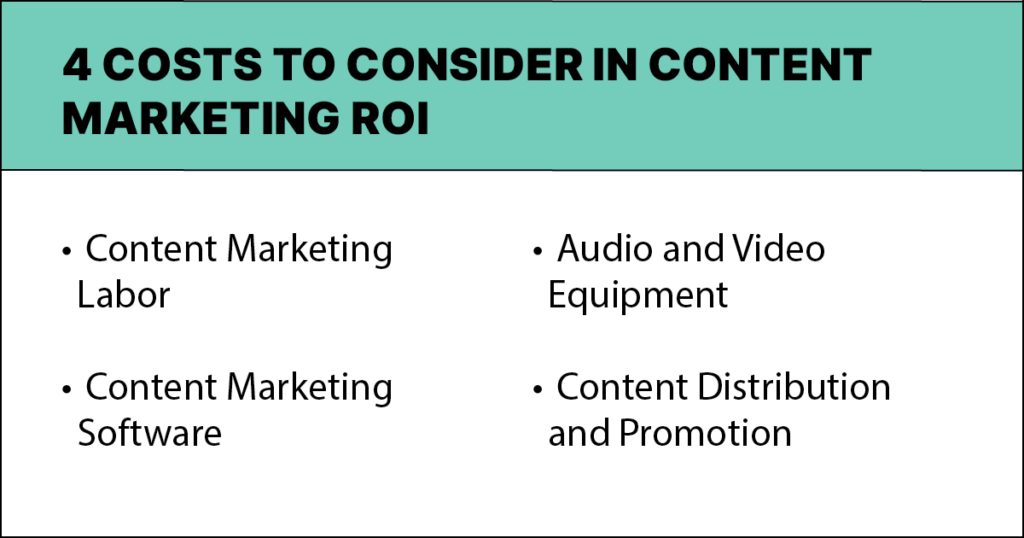The pressure to calculate content marketing ROI can make any marketer sweat. Maybe you feel uncomfortable discussing return on investment. Maybe you’re not sure what metrics and key performance indicators you should be tracking. You’re a pro storyteller, but can you weave a tale about results using data?
There’s no reason to be scared — even if the CEO is doing a budget review and asking every department to present. When you understand the strategic purpose of each content marketing campaign and have clear metrics for measuring success, you can confidently calculate and communicate the ROI of content marketing.
Believe me, the value is real. Intelligent, well-structured content marketing campaigns and assets can drive millions of dollars in the pipeline.
“A technical white paper that I wrote had $59 million of closed-won attribution to it,” says Estee Woods, senior director, product marketing, at Yoobic and a former marketing head at multiple other companies.
Wondering how Estee calculated that kind of impact? Learn how to measure content ROI — and report on it — to get buy-in for your next content marketing campaign.
How to Measure Content Marketing ROI
Sounds easy enough, right? Publish some content; track it; report back; wait for those leads, conversions and sales; and run your victory lap. If only life were that easy (and that much of a movie montage). There’s a lot that goes into proving the value of content marketing. Read on to learn about seven things you can do to understand your ROI, prove it and improve it.
Find Multiple Metrics to Measure
There’s no shortage of options for measuring the ROI of content — web traffic, social engagement, lead generation, deals won by source — but no single metric is enough. Nor are the metrics identical across every sales and marketing team.
Start this process by accepting that you will have to develop your own approach to measuring value. “I don’t think there’s any magic attribution model for content marketing,” says Mike Goldberg, content marketing director at Freshworks. He sums up the challenge: “Tying it back to pure ROI has always been difficult.”
For example, engagement statistics are easy enough to report on, but they’ll rarely be enough to calculate ROI or drive a full program. (And they won’t be enough to secure a raise as a content marketer!)
Aim to develop a dashboard of three category metrics that correlate with your organization’s sales priorities.
Brand Awareness and Engagement
These are leading indicators of growth. What engagement stats have historically shown the greatest correlation with future revenue? Take a look at the data generated by your organization’s martech and sales tech stack. If that’s not enough, try examining organic search traffic on your top 10 keywords or downloads of gated assets.
Lead Generation
This one can get messy depending on how your organization defines leads (more on that later). A conservative measurement of lead generation might ask, “How many people who engaged with a piece of content went on to request a demo or call with a salesperson within seven days?”
Sales cycles differ by company and industry, of course. And as you already know, cycle length will affect what types of content you want to produce.
Sales Enablement
We know content marketing contributes to revenue, but showing this in crystal-clear numbers can be the most difficult part of proving ROI.
Here’s a question you might ask: What is the total value of closed-won deals with accounts that engaged with your content at any point in the buyer journey? You can’t take credit for all of that, of course, but you can start to detect patterns and learn from them for future deals.
Other ROI Calculations to Consider
If leadership is intrigued by these high-level metrics, be ready to dig in with additional supporting data.
Be careful about how you attribute, as you might showcase content marketing’s value but offset that with friction elsewhere. For example, if your company uses single-touch attribution, then first-interaction attribution will give complete credit to the first touch point (often a piece of content), while last-interaction attribution will give full credit to the final touch point (usually a sales rep).
Realistically, attribution is likely to be shared. Work with your sales team to determine the right attribution model for accurate reporting — and be open to exploring tech solutions that help you make the case for content. “A lot of companies are launching content intelligence tools to dig deeper into that,” Goldberg says.

Connect Content Strategy to Business Strategy
To make your content marketing more strategic, your program needs to align with the business’ overall strategic objectives.
Instead of starting with an idea for a white paper or report, ask yourself, “What’s the most urgent business problem we’re trying to solve right now?”
The answer is one of several categories:
- Building brand awareness with a modest budget. Campaigns get more traction when you say something interesting.
- Generating qualified leads. Feed content to the right target audience, and you’ll bring people to salespeople rather than them filtering through junk.
- Closing deals faster. Better-educated buyers are ready to close faster.
- Retaining and growing accounts. Content campaigns can expand and deepen relationships with existing customers, giving you a chance to demonstrate value outside of the contract-renewal cycle.
- Recruiting and retaining talent. Your employer brand is essentially the first impression outside candidates have of your organization. And while employer brand content doesn’t directly drive revenue, companies increasingly realize the hard-dollar value of recruiting and retaining talent.
As you explore those high-level strategic areas, get specific. Find your company’s most recent strategic plan — or at least your marketing and sales team’s part of it. Show how your next content campaign directly supports the priorities in that plan — especially the ones that lead to sustainable revenue.
“There’s always a question of whether content is being used in a strategic manner or not,” says Albert Qian, a product marketing manager at SAS. “Come to the table with a clear content marketing strategy that identifies how that content will work up and down the top, middle and bottom of the funnel.”
Tell the story of how each piece of content or campaign can drive leads, revenue or whatever metric adds most value to the conversation. “It comes back to being able to tie the investment in content to a result that they actually care about,” says Josh Gallant, director of strategy at Foundation Marketing and former senior lead of content strategy..
Strengthen the Connection Between Content Marketing and Sales
Identifying content’s strategic use requires an ongoing conversation with the sales team. This will help you set concrete content marketing metrics and goals — and give you inspiration for timely content. “In order to get revenue, we need to talk about the things people care about,” Woods says.
This is the essence of both account-based marketing (ABM) and demand generation programs.
“As a content writer, you have to create content that goes directly to the salespeople,” Qian says. Sales can use blog posts to get the conversation started quickly, while powerful videos can move deals along faster.
Cooperation and communication can also prevent sales-marketing misalignment or even rivalry (think content marketing vs. PPC) that results in content silos. If the marketing team develops content without input from sales, Woods notes, you risk wasting time and resources on content they can’t use. The worst-case scenario? Sales invests in its own content creation (the horror).
Marketing can’t let sales run the show here, however. Salespeople usually push for bottom-of-the-funnel content over brand awareness or nurture campaigns because that’s where they feel the greatest pressure. While you know how strong brand awareness makes deals easier to close down the road, sales can struggle to see that far ahead.
Don’t blame sales! Just be ready. Leave space in your plan to give the sales team quick wins through case studies, data sheets and other collateral. If you give sales the content they need to close a few deals, you’ll earn their buy-in for top-of-funnel thought leadership and educational content.
Align Content Marketing Goals and Metrics
When you calculate content marketing ROI, everyone needs to be on the same page. There’s no exact ROI formula. Plus, many common metrics have varying definitions or can be interpreted differently. Write down the terms you’re using and what they mean — and make sure everyone knows about it.
Here’s just one example: Marketing qualified leads (MQLs). How does the marketing department define this? Does sales define it the same way? What does your chief marketing officer or CEO think it means? You might find different stakeholders view the metric differently or even track different numbers.
“The strategy that I often break it down into is understanding whether it’s top, middle or bottom of the funnel,” Qian says. “Each element of the top-, middle- or bottom-funnel set of content always has an association with a certain type of outcome.”
Top of the Funnel
The top of the sales funnel is about brand awareness. This is where you’ll see blog posts, introductory videos or infographics. The top of the funnel corresponds with the beginning of the buyer’s journey.
Common metrics at this stage in B2B marketing include website traffic, time spent on page, and impressions or shares on social posts.
Middle of the Funnel
Middle-of-the-funnel content should provoke interest, Qian says. These prospects want to learn more about your product or service — and see what it can do for them.
Email newsletter content, high-level thought leadership and white papers satisfy that need. You can measure success here by tracking email opens, clickthrough rates and downloads (for gated content). For content that isn’t gated, like long-form SEO blog posts, look at organic traffic and time on site.
Bottom of the Funnel
By the time prospects get to the bottom of the sales funnel, they’re ready to make a decision. This stage includes content related to products or services, like data sheets.
Metrics for the bottom of the funnel might include the number of demos requested or exploratory calls scheduled per piece of content.
Once you’ve decided what content you’re producing and the metrics you’ll use throughout the sales cycle, you can work with your sales colleagues to define which actions trigger MQL status. This helps everyone track qualified leads — and is a live demonstration of content marketing’s power.
Calculate Your Content Marketing Expenses
Now that we’ve figured out how to calculate the return, it’s time to talk about the investment. Here are some of the most significant expenses that go into a content campaign.
Content Marketing Labor
Whether you use in-house resources or outsource your content creation to freelancers or an agency, you’ll need people to do the work.
First, you’ll need to account for strategy work. Creating content calendars, fine-tuning campaign details and developing consensus with team members all takes time and energy.
You’ll need people to write and/or edit copy — and the degree of difficulty depends on the subject matter. Less-experienced writers might save you money, but consider how much time and money you’ll spend on editing.
“Writing with subject matter expertise is expensive,” Qian says. “If you just hire anyone off the street, you definitely get what you pay for.”
Depending on the kinds of assets you create, you may also need audio and video editors, designers, developers and other creatives.
“For all the leaders who read this article and think that ‘I can just put one of my digital marketers part-time on content and now I’ve got content marketing,’ I implore them to think about actually investing in a content marketing team to do it right,” Qian says.
Content Marketing Software
Aside from the tools you already use for ABM or marketing automation, look at technology specific to content marketing. This includes content management systems (WordPress), SEO analytics tools (SEMRush), AI-aided content creation (Writer, Lately), content planning and social media scheduling (CoSchedule), and content experience (Uberflip).
If you produce design or multimedia work in-house, you’ll need software subscriptions, too.
Audio and Video Equipment
There are microphones and cameras, and then there are microphones and cameras. How much audio and video content you create in-house will influence your purchasing decisions here, as well as whether you use staff or contractors.
If producing podcasts or videos in-house is part of your content strategy, for example, you’ll need to include professional-level equipment and training in the total investment cost.
Content Distribution and Promotion
For every viral content campaign, countless content goes unseen because no one promotes it. And by promote, we mean a sufficient paid advertising campaign. Without content promotion, it won’t matter how amazing your creative is.
While you might not have direct control of your brand’s advertising budget, you can educate yourself on how that budget is determined and allocated. That budget will influence what’s available for you.
For example, if a campaign has a $50,000 marketing budget, with the expectation that it generates $500,000 in revenue, you probably shouldn’t expect to be able to spend more than $15,000 on the content creative.
Because of this, think through content ROI in the context of the full campaign rather than purely trying to isolate the impact of a single asset. You can still compare and contrast campaign performance based on specific types of content or whether that content was high quality.

Use Storytelling to Improve Your Content Marketing ROI
The bottom line is that ROI needs data, but not every situation demands an exclusive focus on data. When you present content marketing’s value, tell a story!
Numbers have their place, but data-heavy presentations overwhelm and bore people. Stats also provide an excuse to derail — the more stats you throw up on the screen, the more likely someone will interrupt with side arguments or nonessential questions.
Remember, you’re a storyteller — find the data points that illustrate the business problem you’re solving. “Figure out what number matters most, and then work back from that,” Gallant says.
Try to connect that value all the way down the funnel. For example, show how an investment of $5,000 dollars in content can potentially lead to $50,000 in pipeline for the company. Your numbers may vary, of course!
“Find the most efficient way to do that as possible by cutting a lot of the middle pieces,” Gallant says. “When we’re trying to pitch and get buy-in on the investment itself, the focus should be on that far-to-the-right end number.”
Your pitch should lay out the pipeline opportunity. Kick off the presentation with the most essential pieces and high-level points — and get to the point quickly.
“Don’t lead with a bunch of numbers and lose them right away,” Gallant says. “Then it just becomes a game of trying to explain organic search and inbound marketing when you want to really focus on what the opportunity itself is.”
You should also address a campaign’s time frame. Evergreen content might not drive leads right away, but it can have the longest shelf life of any content type. For example, a blog post by Goldberg was the first touch point for a $7 million deal — two years after he wrote it.
Content at different points in the funnel have different lead times for delivering value to the bottom line. Present examples from previous campaigns to help make your case.
Track Content Campaigns Continuously
Without data, you’ll never determine content marketing ROI. Implement frequent testing to identify what content creates the biggest effect. “Go into it like a scientist,” Woods says. “Track everything weekly.”
Track content-generated leads by content across the sales cycle. When a lead comes in, score and qualify it. This practice helps you identify what’s driving the most late-stage conversions. You can use that knowledge to refine your content strategy over time.
“We learned that our long-form technical white papers were converting people at late stages within the funnel,” Woods says of a previous role. By the time someone downloaded a technical white paper, they became an opportunity almost immediately.
Don’t confine lead tracking to gated content: You can leave a piece of content ungated and still track clicks, click-throughs and conversion rates. Run tests on your website to see what content has the biggest impact — and at what point in the sales cycle. Are your landing pages enticing visitors to hand over their contact information for a gated white paper? Do your ungated blog posts score well for the SEO terms you’re seeking?
Figure all that out, then fine-tune your content calendar to improve your chances of converting.
Be ready to report regularly throughout a campaign. Many executives expect this level of detail, but it’s also a good habit. Of course, if you presented on a metric, you should report back on how the campaign is tracking against your goals — even if it’s not exactly what you expected. Regular tracking and reporting will also make your forecasting better over time.
If the campaign underperforms, don’t hide it by, say, reverse-engineering Google Analytics data to show marginal results from a top-of-the-funnel campaign. Instead, explain what happened and how you’ll try to fix it, Gallant says.
You’re more likely to earn ongoing investment when you acknowledge a problem and solve it than by hiding.
Content Marketing ROI Is an Ongoing Effort
If you were hoping for a simple formula here that only content marketing would “own,” sorry. Ultimately, content marketing ROI is best calculated and communicated in the context of a full team effort.
If you excel at all of the above and find huge success, your organization will recognize how content drives value. Of course, you’ll have to do it again. On the flip side, if a campaign performs unevenly, embrace the opportunity to investigate, learn and revise. Tomorrow’s a new day, and content marketing ROI is always waiting for you.






